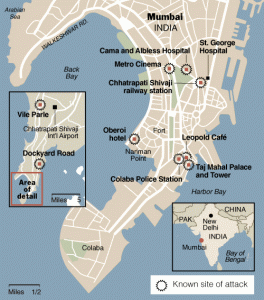This article is part of our “Sacred Cows Week.”
The fight over funding the federal government and raising its debt limit may be over for the moment, but other debates rage on. One of the more vexing ones that has been touched upon most recently in the arguments over possible military intervention in Syria is the relationship between America’s defense posture and its role in the world.
Both parties, in fact, seem to be at a loss in grappling with this question. While the Administration has had to walk a fine line regarding appearing weak over threats made with regard to Syria and landing the U.S. in a war it does not want, the Republicans and like-minded conservatives have been debating amongst themselves policies ranging from American retrenchment, advocated by the likes of Rand Paul, and paying the price of continuing and indeed extending American primacy, as advocated by organizations such as the American Enterprise Institute.
Lost in the heated argument, however, are certain immutable facts regarding the situation America is actually in when it comes to defending itself and its allies. The picture that emerges does not look good either for those who want America to come home or for those who favor a more expanded international security role. Looking at it, though, is the first step toward any kind of sane defense policy, one which probably will not resemble that advocated by either camp.
Submitted for consideration, therefore, are eight of these realitiesm:
1. America’s defense posture is driven largely by its expensive and possibly unsustainable counterproliferation policy.
Ever since the fall of the Soviet Union, and to some extent before, U.S. foreign policy has fixated on preventing the horizontal proliferation of nuclear weapons. While the exact number of weapons held by states already recognized as nuclear powers (particularly the five declared nuclear states under the Non-Proliferation Treaty) might be up for negotiation, the U.S. has endeavored with all the means at its disposal to prevent new nuclear powers from emerging. Although a wide variety of policy tools are at the U.S.’ disposal to accomplish this, the most critical ones have involved the U.S.’ overall military posture: the U.S. has sought either to reassure allies that it would come to their aid (with its nuclear arsenal) if they were attacked, or else to use force to prevent hostile states from acquiring nuclear arsenals of their own. The former policy has encompassed the likes of South Korea, which the U.S. is reported to have talked down from building its own nuclear arsenal in the 1970’s. The fact that three key U.S. allies in the Pacific – Japan, South Korea, and Taiwan – could easily go nuclear in a matter of weeks or months if they ever feared for their safety and doubted U.S. resolve reinforces the point: the U.S. has to maintain enough spare military capability to defend these allies if it wants to convince them they do not need nuclear arsenals of their own.
It used to be that the U.S. protected key allies because they could not protect themselves. Increasingly, the U.S. protects its allies because it fears they will protect themselves.
Interestingly, this also has effects when it comes to the U.S.’ management of its nuclear deterrent against larger powers. Since the U.S. military cannot be everywhere at once, a critical component of the U.S. security umbrella is its willingness, if necessary, to use nuclear weapons in a crisis – this being the case, it cannot renounce the first-usage of nuclear weapons as some arms control advocates have suggested. That is, unless, of course, it comes up with far, far more conventional resources, for the problems of which see what follows.
As for preventive warfare, the fact that this policy led to a woefully misguided war in Iraq – in which suspicions of a nascent nuclear arsenal turned out to be completely false – has not prevented two successive U.S. presidents – Bush and Obama – from threatening the use of force to shut down or delay the Iranian nuclear program. (While it is essentially too late to do anything about North Korea’s nuclear program, the latter is almost certainly the exception that proves the rule: the U.S. has done everything it could afford to do, and it remains militarily engaged, even if it has avoided open war.)
There are other reasons why the U.S. maintains so much force projection capability, of course. What cannot be denied, however, is that as long as the U.S. remains committed to preventing a nuclear arms race along the edge of the Eurasian landmass (what the strategist and former U.S. national security adviser Zbigniew Brzezinski called the “arc of crisis”), its military commitments to the world at large cannot be allowed to shrink. Which brings us to…
2. There is no one else who can shoulder or share the burden of enforcing the counterproliferation regime, and a number of powerful states are seeing to it that the U.S. carries great expense from doing so.
By all publicly available accounts, Iran bled the U.S. in Iraq after it invaded to stop a purported Iraqi nuclear arsenal; it then held great influence over, and access to, the new, Shi’ite led government. The next time, wherever it occurs, will be worse. We have only to imagine what China or even Russia might do in the event of a U.S. invasion of Iran.
Conversely, there is literally no great power anywhere – not Europe, not China, not Russia – that can either wage war to stop would-be nuclear proliferators or guarantee the security of smaller states that might otherwise seek arsenals for their own defense – even if any of these states had any inclination to do so. As long as the U.S. remains committed to keeping the nuclear genie in the bottle, it is on its own. And speaking of which…
3. America’s strategic rivals are getting more powerful.
China and Russia are both modernizing their militaries. Russia plans to modernize its military extensively by 2020, with a particular emphasis on new fighters for its air force and submarines for its navy – the projected expenditure by the end of the decade amounts to $650 billion – about a third of Russia’s annual gross domestic product. (For comparison, imagine a U.S. rearmament program that deployed $500 billion a year for ten years on top of current U.S. expenditure.)

China is in the process of acquiring aircraft carriers and long-range precision-strike capabilities that will both expand its military reach and pose a problem for U.S. naval operations in the Pacific. It is in the process of testing missiles that – potentially – could sink U.S. aircraft carriers in a naval confrontation before they were in range to launch their aircraft. Iran has also tested a short-range version of this technology, which could potentially render aircraft carriers – the most lethal and most expensive assets in the U.S. military and the very symbol of American power – as irrelevant as battleships in World War Two.
Defending U.S. allies, in other words, will be more difficult in the next ten years than in the past twenty. Of course, that’s only if the U.S. can even use its military in such a scenario, because…
4. America’s greatest strategic rival is also its greatest foreign creditor.
The U.S.’ ability to defend its allies is in one sense dependent upon the goodwill of the state it might have to defend many of them from, namely, China. Although as of this writing U.S. federal debt is essentially being monetized (at the rate of about $85 billion a month) by the U.S. Federal Reserve, once the long-anticipated “taper” begins, the U.S. will once again be resorting to foreign credit markets. To date, China, with about $1.3 trillion of the $12 trillion of U.S. debt held by the public, is the U.S.’ largest single foreign creditor, narrowly beating Japan’s $1.15 trillion. (In the larger picture, about 47 percent of U.S. federal debt held by the public is owned by foreign governments.)
It is far from clear what might happen to the U.S.-China debtor-creditor relationship – or the U.S.’ relationship with any of its other international creditors – in a crisis. But at the moment, with the U.S. running deficits in excess of $700 billion annually, a situation that, although ameliorated by the sequester, will get worse in this decade as entitlements are strained by an aging population, the U.S. has to tread carefully. We do not know what would happen to the bond markets if the U.S. attempted to fight a war its foreign creditors disapproved of. There are powerful incentives for foreign creditors to say nothing (they obviously do not want their assets to fall in value), but that is not the same thing as saying that there are no risks. Speaking of budgeting…
5. Where the defense budget is concerned, it doesn’t get any better than this.
A less-remarked-upon consequence of the fiscal “sequester” has been a slow erosion of overall U.S. military readiness. On 19 September, the chiefs of staff of the various armed forces testified before the House Armed Services Committee that extension of the current fiscal path prescribed by the Budget Control Act of 2011 – the fiscal compromise that led to the so-called “fiscal cliff” and “sequester” of government spending – would leave U.S. military readiness at an all-time low. Most dramatically, according to Army Chief of Staff Gen. Ray Odierno’s testimony, 85 percent of U.S. Army brigade combat teams would be unready to fulfill their mission requirements. All of the services have already furloughed civilian employees as a result of the sequester, and all of them now face personnel cuts in fiscal year 2014.
The “sequester” was part of a larger effort to control federal spending at a time when deficits had topped $1 trillion a year. Although federal discretionary spending is now being cut in accordance with these measures, little has been done to address the most important long-term drivers of federal debt: Medicare, Medicaid, Social Security, and related entitlement spending, all of which are likely to increase as members of the postwar baby boom generation hit retirement age (the first people generally thought to belong to that demographic began to reach age 65 in 2011). Until these large segments of the federal budget are addressed, even the sequester will not keep deficits down. The latest CBO projection has U.S. federal debt held by the public beginning to climb relative to GDP around the year 2018 after a temporary decline. This, of course, assumes nothing goes seriously wrong with the U.S. economy in the interim.
Not only do deficits remain a long-term problem, but when faced with a choice between their retirement programs and their foreign policy, or between investment capital in an anemic economy and their foreign policy, it is quite likely Americans will choose the former, and there is little that can be done about this for the foreseeable future. It is simply unlikely there will be much more money for anything more than maintaining the status quo in the near future, and even that will be costly and politically divisive.
(It is sometimes claimed either that defense should be excluded from a solution to America’s fiscal problems or that the required increases in defense spending to maintain the status quo are minimal. Neither is persuasive. Political realities dictate that all options remain open for solving America’s fiscal problems, and however small the increases that are asked for may be, the fact remains both that more will ultimately be needed later and that literally nothing is available. It is not possible to discuss spending increases and budget cuts at the same time.)
In the face of rising challenges to its interests and its allies, the U.S. will have to make do with what it has. And it hasn’t been very good about that so far…
6. America’s defense procurement process is hugely wasteful, makes it near-impossible to know how much we “need,” and could cause the U.S. to lose a war.
There is far, far too more that can be said about this than there is space here to write, but, in short, there are serious problems with the way the American military gets its weapons that are rooted in the structure of American governance itself. Put simply, defense projects are local employment programs even when they are national liabilities. Even congressmembers who want to avoid excessive defense spending find it difficult to resist the temptation to vote for programs that route defense money to their districts. In many respects, they would be foolish not to, since, unless a concerted effort is made, the money will likely be spent somewhere regardless, and, from the point of view of their constituents, might as well be spent in their districts so as to recoup tax dollars that would otherwise go elsewhere.
The result is so well-known it has led to its own peculiar slang, documented by defense reform advocates such as Donald Vandergriff, Pierre Sprey, Chuck Spinney, and others. “Front-loading” refers to a contractor offering Congress an overoptimistic cost projection for a weapons system, on the theory that when it costs more, Congress will sink in the requisite extra cash. “Gold-plating” refers to making a weapons system as complex, elaborate, and expensive as possible, the better not only to sell more goods to the federal government, but also to spread the ensuing expenditures among more congressional districts to make a program harder to kill.
The result can be seen in weapons systems like the F-22 and F-35. As a number of defense analysts – notably Pierre Sprey, James Stevenson, and Robert Dilger – have noted, these fighters are larger, more visible, and (certainly in the F-35’s case) less maneuverable than an F-16, have less fuel available for combat, have poor pilot visibility due to the need to maintain “stealth,” probably are not very stealthy since their vaunted targeting radar systems amount to a homing beacon for missiles and since stealth coating is notoriously difficult to maintain, cannot operate at the same operations tempo due to the need for complicated maintenance, and cost several times more than an F-16. The Air Force’s F-16C fighters were obtained in the 1990’s for about $30 million apiece in today’s dollars; the “flyaway” cost (the pricetag for a single new model, without research or maintenance costs) of an F-22, before the program was cancelled, was $137 million. The flyaway cost of an F-35 ($153-199 million, depending on the version) has now exceeded that figure. Ironically, the F-22 was cancelled because the F-35, which was not designed for air combat and has fewer capabilities, was supposed to be cheaper.
(It is often claimed that one advanced “5th generation” fighter such as the F-22 can defeat several F-16’s. This occurs in tests where the F-16’s are not allowed to use radar-seeking technology to target the F-22’s, and in which radar-guided missiles from the F-22’s are assigned unrealistic kill probabilities. In either case, this ignores the fact that one can get several F-16’s and their pilots for the cost of one F-22. It also ignores the historical fact, documented in a 2006 presentation by James Stevenson, that, because of the dynamics of air combat, the more planes that are involved in an engagement, the closer to 50-50 their odds of survival become, regardless of how they are built.)
What this means in practice is that equipment that are too expensive to replace all at once are replaced slowly, resulting in aging. Sometimes this has alarming results: in 2007, older models of the F-15 had to be grounded because they were too old to fly safely; replacements have been slow in coming. Given the costs involved, the F-35 is currently projected to replace all of the Air Force’s F-16 fleet by sometime in the 2030’s.
While this is a particularly egregious example, what is true of the latest fighter weapons systems is true of other systems as well. The piling on of irrelevant and expensive systems and the obsession with high technology over tactical function doomed the Army’s Future Combat System; similar concerns have been voiced regarding the Littoral Combat Ship and other naval vessels.
What all this means is that discussion of how big the defense budget should be becomes meaningless when no one knows how much waste is acceptable. Likewise, it means that the U.S. may soon field weapons systems that are both too few in number and inadequate for the missions they are assigned – a situation that, if push came to shove, could cause America to lose a war.
A concerted effort to resolve this state of affairs in favor of better, cheaper weapons systems that could be delivered on time would require achieving consensus among a large number of lawmakers from both parties in both houses of Congress, in order to overcome the prisoner’s dilemma involved in funding defense programs. The problems involved are obvious to anyone who reads the news.
Supposing that something could be done, advocates of reform of defense procurement often suggest that the defense budget be cut in the hopes that austerity will force sanity on the process. But it is not clear that it would force enough sanity, particularly given that the U.S. is facing rising military challengers, and particularly given that the U.S. faces tough choices about how to deploy its power in the world that it has yet to address. In particular…
7. The U.S. is a sea and air power that has been acting like a land power.
As many, from Alfred Thayer Mahan to scholars such as Karen Rasler and William Thompson, have noted, sea power – the type of power that can be projected globally – is crucial to maintaining supremacy worldwide. (In modern times, airpower also contributes to this capability.) Major world powers maintain their preeminence by their ability to strike anywhere across the globe, as well as their ability to keep sea lanes open to their commerce and keep potential foes at arm’s length. Sea powers are more easily challenged when they become bogged down on land – spending money on large, expensive land wars such as modern “nation-building” means a military top-heavy with land forces that are only deployable in a limited context. (Rasler and Thompson’s book advancing this argument, The Great Powers and Global Struggle, although rather technical, is very much worth a read for those with a serious interest in this subject.)
When resources become scarce and a world power is starved of fiscal oxygen, one would expect blood to concentrate in vital organs: one would expect it to abandon land-based commitments in favor of maintaining its navy and, in the modern era, its air force. Yet the fact is that the U.S. has spent most of the past decade involved in manpower-intensive, land-based police operations that forced it to push all available surplus resources into increasing the size and capabilities of its two land services, a trend that has only recently been reversed and will take time to undo. Since that time, virtually all of the debate surrounding U.S. foreign policy to date has concerned foreign nation-building, rather than the more pressing question of how to maintain naval and aerial preeminence in order to deter potential adversaries from attacking us or our allies and respond quickly in an emergency.
Which brings us to the crux of the matter.
8. Nothing in the foreign policy debate within the U.S. to date has addressed these basic problems.
Those who want America to take a more modest view of its international role must deal with the reality that the nuclear counterproliferation regime – which everyone professes to be concerned about – depends on a large, flexible, and forward deployed U.S. military and a massive alliance network. These concerns cannot simply be wished away; they drive to the very heart of what the U.S. has to fear in the modern world, more so even than great power rivalry in its own right. They determine which allies the U.S. must keep and protect, in which regions American power must be deployed, what type of arms races the U.S. must engage in, who is the enemy, who is a friend, and, in short, who matters. There is no easy way out of this problem. To pursue American retrenchment over the long term is to decide – probably for our lifetimes – that a world full of nuclear armed states would be an acceptable price to pay for whatever benefits are sought by drawing down our forces and our posture.
On the other hand, those who want America to intervene in conflicts such as that in Syria, and believe this type of intervention to be crucial to the national security, must address the fact that there simply isn’t any more money for such activities, and that there are more important things to be worried about. They are, at best, missing the point altogether. At worst, they are wasting valuable resources at a time when no expenditure can be thought unimportant – when the money simply isn’t there.
It would be good if, in the course of our public debate about our role in the world, which, like it or not, we will have, we paid attention to these troublesome facts that do not seem to want to go away.
References:
Martin Skold is currently pursuing his PhD at the University of St. Andrews in Scotland, with a dissertation focused on analyzing long-term security competition between states.

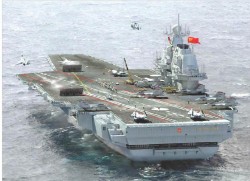
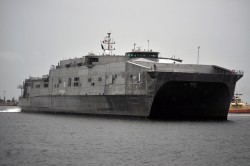
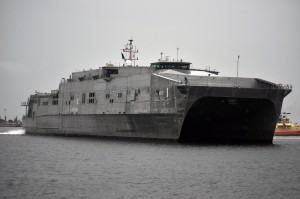 What platform would fill this role exactly? Perhaps a new program is needed, or perhaps an existing program can be adapted such as the Littoral Combat Ship (LCS) or the Joint High Speed Vessel (JHSV). One thing is for sure, it won’t be the DDG1000 or the Gerald R. Ford aircraft carrier. The Mobile Landing Platform (MLP) and its variant, the Afloat Forward Staging Base (AFSB), are promising programs. John Glenn, the second in this line produced by General Dynamics, was just floated in San Diego this past September. Essentially a modified oil tanker, these 840-foot vessels offer a plethora of storage space, a large open deck, and ballast tanks capable of flooding parts of the deck to take on hovercraft. MLPs may not be the quality of technological superiority that we are used to; but at a mere $500 million a copy, they bring capability for a price at which we can afford the quantity.
What platform would fill this role exactly? Perhaps a new program is needed, or perhaps an existing program can be adapted such as the Littoral Combat Ship (LCS) or the Joint High Speed Vessel (JHSV). One thing is for sure, it won’t be the DDG1000 or the Gerald R. Ford aircraft carrier. The Mobile Landing Platform (MLP) and its variant, the Afloat Forward Staging Base (AFSB), are promising programs. John Glenn, the second in this line produced by General Dynamics, was just floated in San Diego this past September. Essentially a modified oil tanker, these 840-foot vessels offer a plethora of storage space, a large open deck, and ballast tanks capable of flooding parts of the deck to take on hovercraft. MLPs may not be the quality of technological superiority that we are used to; but at a mere $500 million a copy, they bring capability for a price at which we can afford the quantity.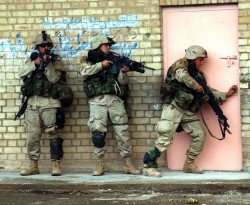
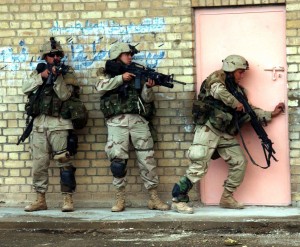 At the operational level, planners can expect warfare to range from the multiple-battalion level assault on
At the operational level, planners can expect warfare to range from the multiple-battalion level assault on 